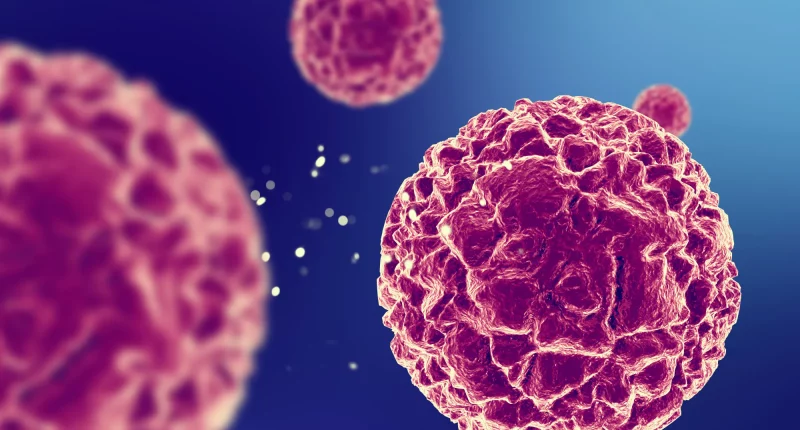Chronic lymphocytic leukemia (CLL) is a type of cancer that specifically affects a subset of white blood cells known as lymphocytes. Lymphocytes are crucial components of the immune system, and they assist the body to fight with infections. In CLL, the cancer primarily targets B lymphocytes, or B cells, which are a type of lymphocyte responsible for producing antibodies to combat pathogens.
In individuals with CLL, the normal function of B cells is disrupted. Rather than supporting the immune system, cancerous B cells proliferate uncontrollably. As these malignant B cells accumulate, they interfere with the production and function of healthy lymphocytes, leading to a weakened immune response.
CLL is one of the most common kinds of leukemia found in adults. According to estimates from the National Cancer Institute, approximately 20,160 newly affected people with CLL were diagnosed in the U.S. in 2022.
Symptoms
The symptoms of CLL can vary widely. In some cases, individuals may not experience any noticeable symptoms, and the cancer is only identified through a blood test. However, when symptoms do occur, they typically include persistent fatigue, high temperatures in the body, frequent infections, and unexplained weight loss. Other common signs are chills, night sweats, and swelling of lymph nodes.
Throughout a physical examination, a healthcare provider might detect enlargement of the liver, spleen, or lymph nodes. This enlargement can indicate that cancer has been transmitted to the organs, a situation often associated with advanced stages of CLL. If this occurs, you may experience discomfort lumps in the neck, or a feeling of swelling or fullness in your abdomen.
Causes and Risk Factors
The exact cause of chronic lymphocytic leukemia remains unknown. However, certain risk factors have been identified that may increase an individual’s likelihood of developing the disease. As stated by the American Cancer Society, several factors are associated with a higher risk of CLL.
Age is a significant risk factor, as CLL is uncommonly diagnosed in individuals aged below 40. Most cases are found in individuals aged 50. Gender also plays a role, with men being more frequently affected than women. Another factor is monoclonal B-cell lymphocytosis, a condition characterized by elevated levels of lymphocytes, which carries a small risk of progressing to CLL.
Environmental factors include contact with certain chemicals, like Agent Orange, which has been linked to an increased risk of CLL. Additionally, a family history of the disease can elevate an individual’s risk; those with relatives diagnosed with CLL are at a higher likelihood of developing the condition themselves.
Diagnosis
When diagnosing CLL, healthcare providers use several different examinations to confirm the presence of the disease. Here’s an overview of some common tests used:
- Complete Blood Count with White Blood Cell Differential: This blood test measures the number and types of cells within the blood, including white blood cells. If you have this condition, you’ll have an unusually high number of lymphocytes, a type of white blood cell.
- Immunoglobulin Testing: This blood test checks the levels of antibodies in your body. Antibodies are crucial for fighting infections. In CLL, you might have lower levels of these antibodies, indicating a weakened immune response.
- Bone Marrow Biopsy: A healthcare professional sends a needle into the pelvic bone, hip bone, or sometimes the breastbone to take a tissue of the bone marrow. The sample is then examined to check for abnormal cells that could indicate CLL.
- CT scan: A CT scan provides detailed images of the inside of your body. Your healthcare provider uses these images to check for swollen lymph nodes in areas like your abdomen or chest, which can be a sign of CLL.
- Genomic and Molecular Testing: These examinations analyze the proteins, genes, and chromosomes in your cells. They help identify specific changes or mutations related to CLL, determine how fast the disease might progress, and guide treatment options. Techniques like polymerase chain reaction and fluorescence in situ hybridization are used in these tests to detect genetic changes.
These tests together provide a comprehensive view of your condition and help healthcare providers develop an effective treatment plan tailored to your needs.
Treatment
The treatment approach for CLL depends on the risk level of the disease and the specific symptoms experienced by the patient.
For individuals with low risk, doctors may adopt a “watch and wait” strategy. This means closely monitoring the patient for any changes or new symptoms without starting immediate treatment. In many cases, the disease remains stable, and some people may never need treatment. However, if symptoms such as persistent infections, low counts of blood cells, extreme fatigue, night sweats, or discomfort in lymph nodes arise, treatment may be recommended even for those with low-risk CLL.
For those with moderate or high chances, treatment is generally advised to begin promptly. Several treatment options may be considered:
- Chemotherapy: This involves using medications to kill cancer cells. Depending on various factors like the patient’s age, symptom severity, and overall health, chemotherapy can be administered either orally or intravenously.
- Targeted Therapies: These therapies focus on certain aspects of cancer cells, like proteins, genes, or tissues that help the cells survive. Examples include radiation therapy, which utilizes high-energy waves or particles to destroy cancer cells, monoclonal antibodies that bind to proteins on cancer cells, and kinase inhibitors that block enzymes crucial for cancer cell growth.
- Bone Marrow Transplant: For high-risk patients who meet certain health criteria, this treatment involves transplanting stem cells from a donor to help rebuild good bone marrow.
- Surgery: In a few cases, surgery to eliminate an enlarged spleen may be recommended if it has become significantly affected by CLL.
- Blood Transfusions: If the patient has low blood cell counts, blood transfusions may be necessary to increase these levels and enhance overall health.
Each treatment option is tailored to the individual’s condition, aiming to manage symptoms and improve quality of life.
Complications
Treatment for CLL can lead to various complications. Chemotherapy, for example, can weaken the immune system, making you more susceptible to infections. It can also cause uncommon antibody levels and low counts of blood cells. Common side effects of chemotherapy include extreme tiredness, mouth sores, hair loss, poor appetite, and nausea or vomiting. In a few episodes, chemotherapy may even increase the risk of developing other cancers. Radiation therapy, bone marrow transplants, and blood transfusions can also have side effects, which vary depending on the treatment and individual response.
To manage these side effects, your healthcare provider might prescribe several supportive treatments. These can include anti-nausea medicines, additional blood transfusions, prophylactic antivirals or antibiotics, corticosteroids, IV immunoglobulin, or the medication rituximab. It’s important to discuss the potential side effects with your doctor, who can provide guidance on which symptoms need medical attention and how best to manage them.
Outlook
The long-term outlook for CLL is generally positive, with many patients experiencing a good quality of life for many years. Survival rates tend to be higher compared to some other cancers, though individual outcomes can vary based on several factors. These include your age, gender, specific chromosome abnormalities, and the characteristics of the cancer cells. While CLL is rarely healed, advancements in treatment have allowed most people to manage the disease effectively over an extended period.
To get a clearer picture of your personal prognosis, it’s important to consult with your healthcare provider. They can provide insights into the stage of your cancer and discuss the most appropriate treatment options for your situation. Understanding these factors will help you and your healthcare provider plan a treatment strategy that aligns with your long-term health goals.
Summary
Chronic lymphocytic leukemia is a kind of cancer that affects lymphocytes, particularly B cells, leading to an increased number of abnormal cells in the blood. Diagnosis involves examinations like complete blood count, bone marrow biopsy, and CT scans. Treatment options vary depending on the risk level and may include chemotherapy, targeted therapies, stem cell transplants, and supportive measures like blood transfusions. While CLL is rarely cured, most patients have a favorable long-term outlook and can live many years with effective management. Discussing your specific case with your healthcare provider will provide insights into treatment and prognosis tailored to your needs.









